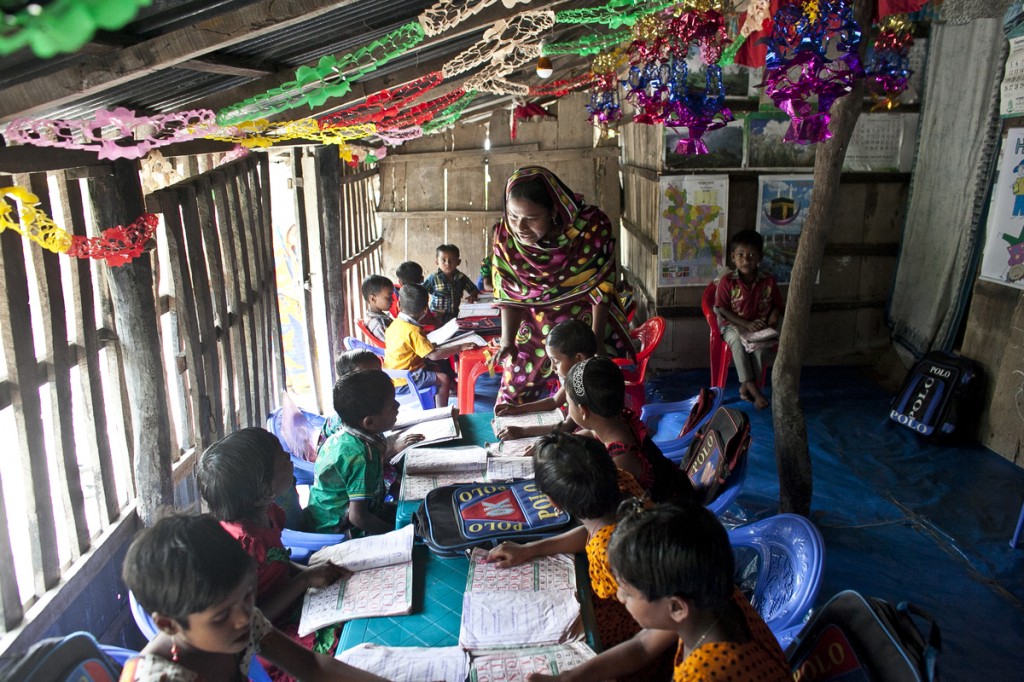15th February 2015
Construction of Pebble centres
At Pebble and Hathay Bunano, the non profit organisation that makes the Pebble toys, we decided very early on that we needed to work with communities and enable them to improve themselves, rather than force change and our ideas upon them. A key example of this is with the construction of the Pebble centres.
Image: the construction of the local buildings may be poor in the very poor communities as in this one in the Sundarbans – at least this one has good light coming through the walls!
When we go to a new community to work we look for local buildings that we can rent from the local community for use for the centre. We never go into communities and build new buildings. Even we don’t do renovations to existing buildings in the early stages. When we go to a community, we accept that community as it is without forcing any changes on it and without disrespecting what they have.
Image: Many new centres will work outdoors when the weather is good because the quality of their buildings is not good and the light may be poor and electricity intermittent
Many of the communities we go to for the first time are very poor – that’s exactly the reason we go there! As such the quality of the buildings available for rent is often very poor. Many buildings are not watertight. Since they are just huts at ground level, there isn’t an issue with safety of the construction but there can be problems with new centres which are not watertight if we start working during the monsoon season.
Image: a production centre working in the outdoors since the weather is good most of the year in Bangladesh
We feel very strongly that changes that are made in the community must be community led and in fact all the community need generally to start to make their own improvements is some regular income. This is what we provide. We provide regular work to communities so that they can start to make improvements to their own homes, send their children to school, education themselves, delay marriages for young women and of course make improvements within the community. We’ve seen such strong community spirit grow from this way of working. We would never go into communities, as outsiders from Dhaka and tell the local community that there buildings are not good enough and that we know better about what needs to be done.
Image: A Hathay Bunano preschool in a poor quality local building – again with light coming through the walls
In the past we’ve worked with some international donors who didn’t understand this policy and insisted that we repair buildings before starting to work. In the end we parted ways with those donors and continued the projects with our own resources, rather than compromising with this policy. I look at it very simply. How would I feel if someone came into my home, a stranger no less, and told me that my home was not good enough and that they were going to change it for me and that I should be pleased! I’d be insulted of course. The women in rural Bangladesh that we work with are no different. They may be poor but they have dignity and it is imperative that we respect that.
Image: where the centres are concerned, we work with what is available and respect what the community have
What is nice, is that after some time we start to see the community make improvements. Sometimes they ask us to contribute and sometimes they just get on with it on their own. I remember particularly one centre in Narshingdi where it was very hot in the summer and we were aware that there was no fan in the centre. So we asked the supervisor of the centre to come in to Dhaka to talk to us. The centre had been running for about 6 months at this time and had started during the cooler winter season. We said to the supervisor that we would like to put a fan in their centre and how would they feel about this. Immediately she told us, ‘there’s no need’. Why? because the women of this centre had been saving 2 tk (about 3c US) a week each for the past couple of months and had bought their own fan and it was already installed. The empowerment that this type of community action brings is priceless. Its one of the unmeasured impacts of many of the centres that we work in and it is joyous when we see it.







